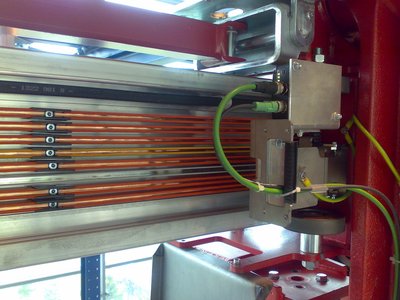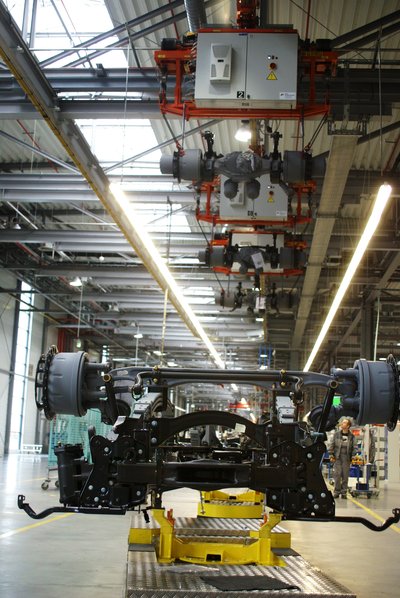Wireless communication in track-guided transport systems
Tuesday, 14 February, 2012
Track-guided transport systems have been used in highly automated production environments for some time now. Whether in automobile production, automation of material flow or warehouse logistics, rail-based mobile units transport the required parts in all of these areas. Normally, communication to the mobile units is established using contact lines and mechanical contacts.
As a result of the increasing amount of data in modern applications, this technology is frequently reaching its limits. A wireless connection using radiating cables provides an alternative solution to address this issue. More compact components are now making this technique easier to handle.
New requirements cannot be implemented using contact lines
The contact lines in conventional solutions, for example in electric monorails (EM), are routed next to one another on the rail, which also supports the transport equipment known as hangers. Using contacts, a serial data connection is established between the hanger and the central control mounted at the end of the rail. The contacts are regularly changed as a result of the mechanical wear. While these contacts are being replaced, the electric monorail cannot be used - which certainly poses a problem for users. There are many new challenges as a result of the continually increasing possibilities brought about by advances in automation. For instance, the amount of data that today’s control solutions have to handle is increasing to such an extent that the usual data transfer rate of a mechanical contact line of 50 Kbps is no longer sufficient. The amount of configuration data that must be uploaded to the control located on the hanger is also increasing. It must be simple and fast to update systems. Data-intensive visualisation opens up new opportunities so that plant operators can remain competitive in global markets. The challenges described cannot be quickly and reliably implemented using mechanical contacts. This is the reason that the data conductors in the rails of EMs are being increasingly replaced by a track-guided wireless medium, which permits high data transfer rates to be achieved: WLAN along the radiating cable.
Proven use in everyday applications
Most users know WLAN as the broadband wireless medium that is often used in industrial environments. Radiating cables (otherwise known as leaky-cable antennas) are taken for granted in day-to-day use without users even thinking about them. Just one example is radio and cell phone reception in tunnels. A radiating cable, which is routed along the complete length of the tunnel ceiling, ensures that cell phones and radios can be used without any problem. In principle, this involves a coaxial cable that has precisely dimensioned openings in its shielding along the complete length. Each of these slits acts as a small antenna. This means that the wireless signal is radiated along the complete cable length and supplies its environment (see Figure 1). The same technology allows passengers to make telephone calls in otherwise well-shielded trains, such as the German Federal Railways ICE express train. Radiating cables are also routed in the passenger cars where the use of mobile phones is permitted. As a consequence, a complex antenna system comprising many individual components is not required.

Reliable integration of difficult-to-access participants
The concept discussed above is also employed if a radiating cable, instead of a contact line, is routed when installing an electric monorail (Figure 2). The low transmitting power of the WLAN access point connected at its end means that the wireless signal only has restricted coverage. A WLAN client is located as a coupling partner on the hanger of the electric monorail; its antenna is routed at the top close to the radiating cable so that the hanger has a broadband data link. With up to 54 Mbps, the data transfer rate is approximately 1000 times that of a classic contact line solution. An ethernet-based protocol is used for WLAN-based communication, for example, Profinet.
For a centre infeed, the radiating cable - also known as leaky cable - can be supplied by a WLAN access point for a maximum of 200 metres. If the electric monorail is spread out over a wide area, then the roaming function known from wireless systems permits a transition to another section, in which an additional access point is installed. Rail switches or lifting systems can be integrated into the communication network in the same way. The advantage of the radiating cable is the uniform wireless field along its complete length. In this way, areas that are otherwise difficult to access, such as automatically closing gates at the transition between two halls or transitions between two different floors of the building, can be reliably supplied.

Compact WLAN client with integrated antenna
The mobile WLAN client on the hanger has a decisive role to play. Generally, a standard industrial-grade WLAN client is located next to the control. The special antenna connected through a cable is mounted at the top next to the rail in order to ensure a good connection to the radiating cable. A typical clearance of about 10 cm is maintained when installing the antenna. Conventional industrial WLAN modules are relatively large and take up a lot of space in the control box on the hanger. What also has to be taken into consideration is that the special antenna and the sensitive antenna cable require further installation work and generate additional costs.
Fortunately, compact WLAN modules with integrated antennas are available to simplify installation. An example is the FL WLAN EPA WLAN ethernet port adapter from Phoenix Contact, which is approximately the size of a pack of cigarettes and has a circular polarised antenna, especially suitable for radiating cable-based communication, installed in the housing. This means that the WLAN module can be installed directly on top of the hanger instead of the antenna. The device is then connected with the ethernet port of the control using a standard cable. This reduces the chance of making errors when installing the sensitive antenna cable, and there are no cable signal losses with an integrated antenna.
The size and performance of the WLAN components also play a significant role in other track-guided applications (Figure 3). In the example of skid conveyors, a flat surface moves directly over the floor. This pallet, which is frequently used in the automobile industry to assemble vehicles, requires an unobstructed surface on its upper side. As a consequence, all of the control and other devices must be accommodated on the lower side in the smallest amount of space possible. This is the best prerequisite for the WLAN Ethernet Port Adapter, which only requires a small amount of space between the pallet and the floor. The FL WLAN EPA establishes the wireless connection to the radiating cable routed in the floor of the assembly area or hall.

Conclusion
All systems that employ a radiating cable-based communication system profit from the advantages of the guided wireless field along the cable - and especially from the reliable transmission of larger data quantities. In track-guided systems this also results in lower maintenance overhead due to the elimination of contact lines and mechanical contacts.
Enabling OT continuous monitoring
ICS environments have historically had fewer cybersecurity tools designed to interrogate...
IO-Link and the role of the IO-Link Master
While it is true that IO-Link is plug-and-play from a hardware perspective, it pays to do your...
Security enhanced for digitalised industrial boilers
Industrial boiler maker Bosch Industriekessel depends on secure gateway technology to offer...












